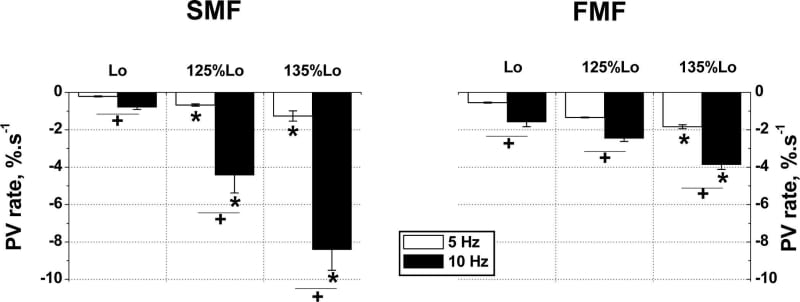Muscle fatigue was studied during electrically stimulated long-lasting activity of single fibres isolated from m. gastrocnemius of humanely killed Rana ridibunda. The experimental protocol assessed individual and combined contribution of fibre stretch and stimulation frequency for fatigue-induced alterations in extracellular action potential (ECAP) parameters on different muscle fibre types. Fibre activity was induced via 5 or 10 Hz frequency suprathreshold stimulation, applied for 180 s. The fibres were stretched by 25 or 35% from the initial length (L0), determined as the length at which maximal twitch was evoked. ECAPs were recorded via pairs of electrodes with a fixed interelectrode distance, situated parallel to the fibre axis and close (15-20 μm) to the membrane, distant from the stimulating electrode and the fibre end. The rates of percentage change in propagation velocity of excitation (PV), ECAP time parameters and median frequency (MDF) of ECAP power spectrum were calculated for the period of uninterrupted activity (endurance time, ET). Non-parametric k-independent samples Kruskall-Wallis H test and 2-independent-samples Mann-Whitney U post-hoc test were applied to identify the statistical significance of main and interaction effects of fibre length and stimulation frequency. Paired Wilkoxon signed rank test was used to test the significance of fatigue induced parameter changes. ET was followed by an interrupted activity period consisting of alternating action potential propagation failure and restoration. This pattern is dependent on fibre type and experimental protocol, thus fibres were classified as slow (SMF) or fast (FMF) fatigable according to the rate of PV decrease at L0 and 5 Hz-stimulation (Radicheva et al. 1998), and by histochemical assessment of their myosin ATPase activity. ET decreased (up to 92%) and the rates of parameter changes increased (>200%) significantly with fibre stretch and faster stimulation in both fibre types. At lower stimulation frequency and fibre stretch the rates of parameter changes of SMFs were less than those of FMFs, while simultaneous fibre stretch and higher stimulation frequency induced lower rates of parameter changes in FMFs compared to SMFs (Fig.1). ECAPs reflect the changes in intracellular action potentials, which are dependent on the ionic conductance of the muscle fibre membrane. The differential effects of stimulation frequency and fibre stretch during fatigue on electrical activity of different muscle fibre types were most likely due to differences in the membrane properties of the fibres.
University of Bristol (2005) J Physiol 567P, PC81
Poster Communications: Fibre length and stimulation scheme associated changes in muscle fibre fatigability
Radicheva, Nicolina; Mileva, Katya; Vydevska-Chichova, Mariela;
1. Academy of Sport, Physical Activity and Well-being, FESBE, London South Bank University, London, United Kingdom. 2. Department of Excitable Structures, Institute of Biophysics, Bulgarian Academy of Sciences, Sofia, Bulgaria.
View other abstracts by:
Figure 1. Rates of PV percentage change during ET at 3 fibre lengths and 2 stimulation frequencies; (mean ± S.E.M. n=24 *p<0.05 vs. L0 stimulation frequency effect +p<0.05 vs. 5 Hz).
Where applicable, experiments conform with Society ethical requirements.

